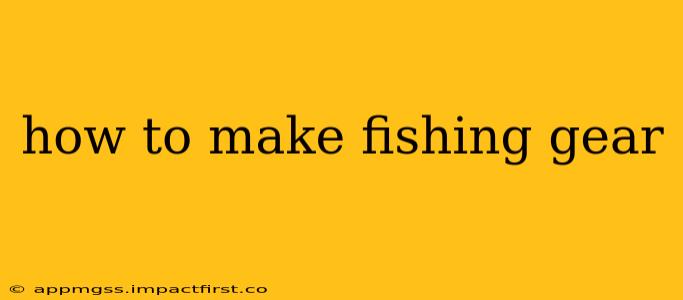Fishing is a rewarding pastime, connecting you with nature and providing a delicious meal. But the cost of commercial fishing gear can add up quickly. Luckily, many essential pieces of fishing equipment can be made at home with readily available materials, offering a satisfying DIY project and potentially significant cost savings. This guide will walk you through creating several types of fishing gear, from simple lures to more complex tackle.
What Kind of Fishing Gear Can I Make Myself?
You can surprisingly create a variety of fishing gear at home, including:
- Fishing lures: From simple spoons to more complex crankbaits, the possibilities are vast.
- Fishing bobbers (floats): These buoyant devices help keep your bait at the desired depth.
- Fishing weights (sinkers): Essential for casting and controlling your bait's depth.
- Simple fishing hooks: While making your own hooks from scratch is challenging, you can modify existing hooks for specific applications.
- Fly fishing flies: This requires more skill and specialized materials but offers great creative potential.
- Fishing line spools: While you won't make the line itself, you can create custom spools to organize your line.
How to Make Simple Fishing Lures
Let's start with the most accessible DIY fishing gear: lures. These attract fish with their movement and appearance. Here's how to make a basic spoon lure:
Materials:
- A piece of sheet metal (aluminum or brass works well)
- Strong fishing line
- Small swivel
- Split ring
- Hooks
- Drill with small drill bit
- File or sandpaper
- Paint (optional)
Instructions:
- Cut the metal: Cut the metal into a spoon shape – a roughly oblong shape with a slightly curved concave side. Experiment with different shapes and sizes.
- Drill holes: Drill a small hole at the top for attaching the split ring and swivel. Drill another hole near the bottom for the hook.
- File and sand: Smooth out any rough edges with a file or sandpaper for a clean finish.
- Attach the components: Attach the split ring to the top hole, then the swivel to the split ring. Attach your hook to the bottom hole.
- Paint (optional): Add paint to enhance the lure's attractiveness to fish.
How to Make Fishing Bobbers (Floats)
Fishing bobbers are essential for keeping your bait at a specific depth. Here's how to make a simple cork bobber:
Materials:
- A wine cork or similar buoyant material
- Fishing line
- Small weight (e.g., a split shot)
- Drill with small drill bit
- Waterproof glue or epoxy
Instructions:
- Drill a hole: Carefully drill a hole through the center of the cork, large enough for your fishing line to pass through.
- Attach the weight: Tie a small weight to the end of the line below the cork. This helps keep the line straight.
- Thread the line: Thread the line through the hole in the cork. Secure the line with a knot and waterproof glue or epoxy.
How to Make Fishing Weights (Sinkers)
Making sinkers is straightforward. You can even recycle materials.
Materials:
- Lead (although environmentally unfriendly, lead is commonly used) or alternative material like steel or tungsten.
- Mold (optional, but recommended for consistent shapes)
Instructions:
- Melt the lead (if using): If using lead, melt it carefully in a well-ventilated area. Always prioritize safety when working with molten lead.
- Pour into mold: If using a mold, pour the melted lead into it.
- Let it cool: Allow the lead to cool completely before removing from the mold.
How to Make Fishing Line Spools?
Commercial fishing line comes on spools, but sometimes you need to switch out spools or create custom storage.
Materials:
- A sturdy base (e.g., a sturdy piece of wood, a plastic container lid)
- A round object slightly smaller than the desired spool size (e.g., a cylindrical container)
- Strong adhesive
Instructions:
- Securely attach the round object to the base. The adhesive should be strong enough to withstand the tension of your fishing line.
- Carefully wind your line around the cylindrical object, building up layers evenly.
What are some good materials for making fishing lures?
Many materials work well for making fishing lures, including:
- Wood: Balsa wood is popular due to its lightness and workability. Other hardwoods can be used for more durable lures.
- Plastic: Many plastics, such as ABS or acrylic, can be carved, molded, or layered to create unique lures.
- Metal: Aluminum, brass, and lead are commonly used for creating spoons, spinners, and other metal lures.
How do I make my homemade fishing gear more durable?
Durability depends heavily on the materials and construction. For added durability:
- Use high-quality materials.
- Securely attach all components with strong adhesives or fastenings.
- Seal wooden lures with waterproof sealant.
- Apply a protective coating (e.g., paint, varnish) to your lures to enhance weather resistance.
This guide provides a starting point for creating your own fishing gear. Remember always to prioritize safety, especially when working with potentially hazardous materials like lead. Experiment with different materials and designs to discover what works best for you and the fish you're targeting. Happy fishing!
